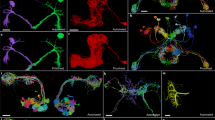Abstract
Effective 3D visualization is essential for connectomics analysis, where the number of neural images easily reaches over tens of thousands. A formidable challenge is to simultaneously visualize a large number of distinguishable single-neuron images, with reasonable processing time and memory for file management and 3D rendering. In the present study, we proposed an algorithm named “Kaleido” that can visualize up to at least ten thousand single neurons from the Drosophila brain using only a fraction of the memory traditionally required, without increasing computing time. Adding more brain neurons increases memory only nominally. Importantly, Kaleido maximizes color contrast between neighboring neurons so that individual neurons can be easily distinguished. Colors can also be assigned to neurons based on biological relevance, such as gene expression, neurotransmitters, and/or development history. For cross-lab examination, the identity of every neuron is retrievable from the displayed image. To demonstrate the effectiveness and tractability of the method, we applied Kaleido to visualize the 10,000 Drosophila brain neurons obtained from the FlyCircuit database (http://www.flycircuit.tw/modules.php?name=kaleido). Thus, Kaleido visualization requires only sensible computer memory for manual examination of big connectomics data.





Similar content being viewed by others
References
Ascoli, G. A., Donohue, D. E., & Halavi, M. (2007). NeuroMorpho.Org: a central resource for neuronal morphologies. The Journal of Neuroscience, 27(35), 9247–9251.
Binder, K., & Heermann, D. (2010). Monte Carlo simulation in statistical physics: An introduction (5th ed.). New York: Springer.
Chiang, A. S., et al. (2011). Three-dimensional reconstruction of brain-wide wiring networks in Drosophila at single-cell resolution. Current Biology, 21(1), 1–11.
Engel, K., Kraus, M., & Ertl, T. (2001). High-quality pre-integrated volume rendering using hardware-accelerated pixel shading. In Proceedings of the ACM SIGGRAPH/EUROGRAPHICS workshop on graphics hardware (HWWS '01), Hanspeter Pfister (Ed.). ACM, New York, 9–16.
Finger, S. (2001). Origins of neuroscience : a history of explorations into brain function. New York: Oxford University Press.
Goldberg, I. G., et al. (2005). The open microscopy environment (OME) data model and XML file: open tools for informatics and quantitative analysis in biological imaging. Genome Biology, 6(5), R47.
Haehn, D., et al. (2017). Scalable interactive visualization for Connectomics. Informatics, 4(3), 29. https://doi.org/10.3390/informatics4030029.
Hampel, S., et al. (2011). Drosophila Brainbow: a recombinase-based fluorescence labeling technique to subdivide neural expression patterns. Nature Methods, 8(3), 253–259.
Hwu, Y., & Margaritondo, G. (2013). Phase contrast: the frontier of x-ray and electron imaging PREFACE. Journal of Physics D-Applied Physics, 46(49).
Landhuis, E. (2017). Neuroscience: Big brain, big data. Nature, 541(7638), 559–561.
Lee, T., & Luo, L. (2001). Mosaic analysis with a repressible cell marker (MARCM) for Drosophila neural development. Trends in Neurosciences, 24(5), 251–254.
Livet, J., et al. (2007). Transgenic strategies for combinatorial expression of fluorescent proteins in the nervous system. Nature, 450(7166), 56–62.
Markram, H., et al. (2015). Reconstruction and simulation of neocortical microcircuitry. Cell, 163, 456–492.
Milyaev, N., et al. (2012). The virtual fly brain browser and query interface. Bioinformatics, 28, 411–415.
Peng, H., Ruan, Z., Long, F., Simpson, J. H., & Myers, E. W. (2010). V3D enables real-time 3D visualization and quantitative analysis of large-scale biological image data sets. Nature Biotechnology, 28(4), 348–353.
Peng, H., et al. (2015). BigNeuron: large-scale 3D neuron reconstruction from optical microscopy images. Neuron, 87(2), 252–256.
Pettersen, E. F., et al. (2004). UCSF chimera--a visualization system for exploratory research and analysis. Journal of Computational Chemistry, 25(13), 1605–1612.
Preucil, F. (1953). Color hue and ink transfer - their relation to perfect reproduction. TAGA Proceedings, pp. 102‑110.
Schindelin, J., Rueden, C. T., Hiner, M. C., & Eliceiri, K. W. (2015). The ImageJ ecosystem: An open platform for biomedical image analysis. Molecular Reproduction and Development, 82(7–8), 518–529.
Schneider, C. A., Rasband, W. S., & Eliceiri, K. W. (2012). NIH image to ImageJ: 25 years of image analysis. Nature Methods, 9(7), 671–675.
Shih, C. T., et al. (2015). Connectomics-based analysis of information flow in the Drosophila brain. Current Biology, 25(10), 1249–1258.
Sigal, Y. M., Speer, C. M., Babcock, H. P., & Zhuang, X. W. (2015). Mapping synaptic input fields of neurons with super-resolution imaging. Cell, 163(2), 493–505.
Small, A., & Stahlheber, S. (2014). Fluorophore localization algorithms for super-resolution microscopy (vol 11, pg 267, 2014). Nature Methods, 11(9), 971–971.
Takemura, S. Y., et al. (2013). A visual motion detection circuit suggested by Drosophila connectomics. Nature, 500, 175–181.
Takemura, S. Y., et al. (2017). A connectome of a learning and memory center in the adult Drosophila brain. eLife, 6, e26975.
Acknowledgments
We thank Chao-Chun Chuang, Yen-Jen Lin and Chun-Yen Lin for their assistance in the interface design and software integration. We are grateful to Hsiu-Ming Chang for editorial suggestions. This work was supported by Ministry of Science and Technology grants 105-2112-M-029-002 and 105-2633-B-007-001, and by the Aim for the Top University Project of the Ministry of Education.
Author information
Authors and Affiliations
Corresponding authors
Ethics declarations
Conflict of Interest
All the authors declare no conflicts of interest.
Electronic supplementary material
Figure S1
Benchmark of Kaleido. A-C: Computing resources used versus the number of neurons processed. A: Execution time. B: Peak memory. C: File size of output file. (PPTX 46 kb)
Video S1
A 360-degree rotating movie showing the volume rendering result of random 10,000 neurons in the FlyCircuit with Kaleido visualization. (MP4 18591 kb)
Video S2
An orthoslice movie showing the section view of random 10,000 neurons in the FlyCircuit with Kaleido visualization. (MP4 25583 kb)
Rights and permissions
About this article
Cite this article
Wang, TY., Chen, NY., He, GW. et al. Kaleido: Visualizing Big Brain Data with Automatic Color Assignment for Single-Neuron Images. Neuroinform 16, 207–215 (2018). https://doi.org/10.1007/s12021-018-9363-3
Published:
Issue Date:
DOI: https://doi.org/10.1007/s12021-018-9363-3




